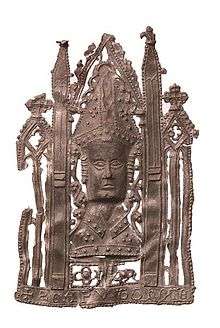Pilgrim badge

A pilgrim badge is a badge typically made of base metal such as pewter or another lead alloy which was worn in the medieval period by Roman Catholic pilgrims. They travelled to sites of Christian pilgrimage, such as in England Canterbury Cathedral, the site of the martyrdom of St. Thomas Becket. Their use flourished in the Middle Ages in Europe, particularly in the 14th and 15th centuries, but declined after the Protestant Reformation of the mid-16th century.[1] Other sorts of badges were also worn by pilgrims, most famously the scallop shell associated with pilgrimages along the Way of St James to the shrine of Saint James at Santiago de Compostela in modern Spain.
Background
Pilgrim badges were cheaply mass-produced by die-stamping or in moulds so that everyone could afford them; typically the design was only on one side of the metal. Pilgrims wore them on their outer clothing and hats or around the neck to show where they had been on pilgrimage. Today, most pilgrim badges are recovered in or near rivers because Medieval pilgrims believed that the badges would bring good luck if they were thrown into water.[2] Many were displayed in the pilgim's parish church after their return, but these have rarely survived.
The same style and technique was used in the Middle Ages for a variety of purposes; livery badges were presented to employees and allies by great figures, and became highly controversial in the decades leading to the Wars of the Roses. Some funerary badges have survived, including a fine one for the Black Prince.[3] Other badges, with motifs such as hearts, were evidently just a form of cheap jewellery. It is often difficult to decipher and classify corroded medieval badges between these types.
The quality of pilgrim badges varied considerably, with some being naive and crudely made, while others, such as some of those made in the late 14th century at Canterbury for the popular shrine of St Thomas Becket, displayed great craftsmanship and skill. Much rarer examples were made in precious metals for the wealthy; these have mostly been recycled for their valuable materials over the centuries.[4] The most popular shrines sold over 100,000 badges a year, making pilgrim badges the first mass-produced tourist souvenir. In 1466, for example, 130,000 badges were sold in a fortnight at Einsiedeln Abbey in Switzerland, yet only a handful of medieval badges from that shrine now survive.[1] Similar statistics can be demonstrated with early prints, another popular form of mass-produced pilgrimage souvenir from the 15th century onwards. These were at first often tiny by modern standards, no bigger than a large postage stamp, and thus affordable even by peasants.
In England the tradition of making and wearing pilgrim badges died out in the early 16th century as pilgrimage initially declined in popularity and was then banned completely as the country became Protestant during the English Reformation, when pilgrimage became regarded as a superstition and idolatrous. The tradition continued in Catholic Europe, however, for some time.
Pilgrim badges usually show an image appropriate to the pilgrimage destination, often including the shrine itself, or a famous image there, or a saint, their attribute, or a scene from their life. These usually enable scholars to identify the shrine from which a badge came.
See also
| Wikimedia Commons has media related to Pilgrim badges. |
References
Further reading
- B. Spencer, Pilgrim souvenirs and secular Badges, Medieval Finds from Excavations in London,(London, Stationery Office, 1998)
External links
- Pilgrim badge depicting St George and the dragon in the British Museum
- Definition of 'Pilgrim badge'
- A Medieval Pilgrim Badge on the BBC A History of the World website
- Kunera, late medieval badges and ampullae database (Radboud University Nijmegen, The Netherlands)